- Thread starter
- #681
Ridgetop
Herd Master
I the new owner's name Noah?
Yet to be determined, but it does help to be able to part the waters...or at least walk on 'em..from one of my rough and rowdy days hereI the new owner's name Noah?
 If this keeps up for several years, we may decide to stay. Especially if the gully fills partially with water and we can stock it with catfish! Maybe this climate change will cause southern California to become a rain drenched paradise!
If this keeps up for several years, we may decide to stay. Especially if the gully fills partially with water and we can stock it with catfish! Maybe this climate change will cause southern California to become a rain drenched paradise! 

I will pull up all STA's posts ad have him read everything Greybeard and others posted about tractors.
DS1 and I changed the rams' crayons today
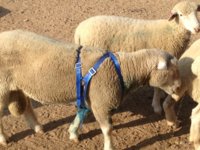
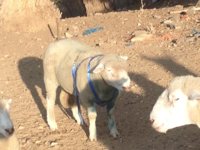 Here is my old Dorset ram wearing a marking harness. The crayon is mounted in a holder under his chest between the front legs, held on by a system of adjustable nylon straps.
Here is my old Dorset ram wearing a marking harness. The crayon is mounted in a holder under his chest between the front legs, held on by a system of adjustable nylon straps.  Here are some ewes after marking The ram was very enthusiastic and the crayon was soft in the heat.
Here are some ewes after marking The ram was very enthusiastic and the crayon was soft in the heat.Again?Send some of that inland sea my way, I already got the beach sand!



 We have comfortable padded large stadium seats, BUT they were in trailer which was in the shop getting checked out before our trip to Texas. Next year I will take them out. Thank goodness the club had made another giant pot of coffee. The rain began to pour down outside.
We have comfortable padded large stadium seats, BUT they were in trailer which was in the shop getting checked out before our trip to Texas. Next year I will take them out. Thank goodness the club had made another giant pot of coffee. The rain began to pour down outside. that it was happening to others and not me. The show settled into a calm routine and I was able to make lots of notes about the entries in the classes I was most interested in.
that it was happening to others and not me. The show settled into a calm routine and I was able to make lots of notes about the entries in the classes I was most interested in.  The walking distance may have sounded great when the board was planning this shindig, but considering the pouring rain no one would be strolling to and from the hotel! Anyway, the food was ok, the drinks ok, and prices very ok, and the company was terrific. We met a lot more fun people and shared lots of livestock stories about ourselves and others. Then back to the good old Best Western for another early night before the auction the next morning. Again it rained heavily all night.
The walking distance may have sounded great when the board was planning this shindig, but considering the pouring rain no one would be strolling to and from the hotel! Anyway, the food was ok, the drinks ok, and prices very ok, and the company was terrific. We met a lot more fun people and shared lots of livestock stories about ourselves and others. Then back to the good old Best Western for another early night before the auction the next morning. Again it rained heavily all night. The powers that be decided to sell from the youngest to the eldest and alternate black and white Dorpers. Very odd. The bidding was kind of low too. Disappointing for the consignors, some of whom had come from Arizona, Washington, Oregon, and Utah. I wrote down all the prices and many animals did not get the minimum bid and were passed out. A few animals went high, but most were going for around $500-700. Anyway, at the end of the auction Yearling White Dorper rams were selling. I ended up buying a yearling ram. I didn't need him, but he was soooo nice I put up my card at the bottom price. Surprise!
The powers that be decided to sell from the youngest to the eldest and alternate black and white Dorpers. Very odd. The bidding was kind of low too. Disappointing for the consignors, some of whom had come from Arizona, Washington, Oregon, and Utah. I wrote down all the prices and many animals did not get the minimum bid and were passed out. A few animals went high, but most were going for around $500-700. Anyway, at the end of the auction Yearling White Dorper rams were selling. I ended up buying a yearling ram. I didn't need him, but he was soooo nice I put up my card at the bottom price. Surprise!  There were no other offers and I got him for $400.00! I was shocked since this breeder sells privately off his ranch for a lot more than this. He told me afterwards that he forgot to put reserves on his rams. The auction was winding down and the last lots were coming in. I was worried since often the highest prices are bid at the beginning and at the end when people realize they need to bid if they want anything. I was lucky enough to get 2 of the yearling ewes I wanted for the minimum opening bid of $400 each! I had to pay a bit more for one of the ewes but $700 was not extreme. Remember these were all registered animals with great bloodlines and structure. After the auction ended, the Utah breeder I had bought 3 animals from offered me another ewe. He had a reserve on her of $1000.00 since he wanted to keep her. I thought she had sold for $700 but since it did not meet the reserve, she didn't sell. He offered her to me and I bought her for $750. Luckily, since that was the end of my budget! I was also offered another ewe by a Dorper exhibitor I became friends with. She did not want her since she was the only White Dorper she had. I would have picked her up on the way home but she was ready to lamb any day and I did not want to take a chance on her lambing on the way home in the trailer. We were already transporting a ram and 7 ewes. Luckily, our 16' stock trailer has 3 compartments. It was designed for the dairy goats so all the doors have sliding gates on the swing gates. So wonderful for loading the small stock with out danger of broken legs from the heavy swing doors! She is giving me a great price on her and I told her I will pick her up after she lambs and the lambs are weaned. The lambs are out of a black headed Dorper sire so the lambs only have value as locker lambs. The meat price on the lambs will help make up the value of the ewe who is an inspected and tagged Type 5. I will pick her up in another 2 months and she will be rebred in September to Lewis along with the fall ewe lambs.
There were no other offers and I got him for $400.00! I was shocked since this breeder sells privately off his ranch for a lot more than this. He told me afterwards that he forgot to put reserves on his rams. The auction was winding down and the last lots were coming in. I was worried since often the highest prices are bid at the beginning and at the end when people realize they need to bid if they want anything. I was lucky enough to get 2 of the yearling ewes I wanted for the minimum opening bid of $400 each! I had to pay a bit more for one of the ewes but $700 was not extreme. Remember these were all registered animals with great bloodlines and structure. After the auction ended, the Utah breeder I had bought 3 animals from offered me another ewe. He had a reserve on her of $1000.00 since he wanted to keep her. I thought she had sold for $700 but since it did not meet the reserve, she didn't sell. He offered her to me and I bought her for $750. Luckily, since that was the end of my budget! I was also offered another ewe by a Dorper exhibitor I became friends with. She did not want her since she was the only White Dorper she had. I would have picked her up on the way home but she was ready to lamb any day and I did not want to take a chance on her lambing on the way home in the trailer. We were already transporting a ram and 7 ewes. Luckily, our 16' stock trailer has 3 compartments. It was designed for the dairy goats so all the doors have sliding gates on the swing gates. So wonderful for loading the small stock with out danger of broken legs from the heavy swing doors! She is giving me a great price on her and I told her I will pick her up after she lambs and the lambs are weaned. The lambs are out of a black headed Dorper sire so the lambs only have value as locker lambs. The meat price on the lambs will help make up the value of the ewe who is an inspected and tagged Type 5. I will pick her up in another 2 months and she will be rebred in September to Lewis along with the fall ewe lambs. 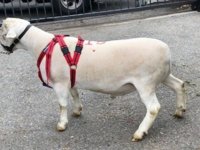
 Here is Axtell harnessed up and ready to do his duty. Love the length and hind quarters on him. My bid card went up all by itself!
Here is Axtell harnessed up and ready to do his duty. Love the length and hind quarters on him. My bid card went up all by itself!
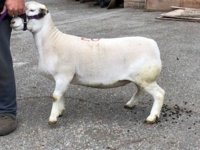
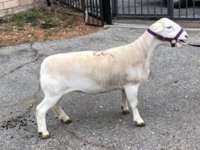
 The other 4 ewes we bough at the auction. This last ewe is an AI ewe from imported Australian lines that we got at the Mother's Day on line sale.
The other 4 ewes we bough at the auction. This last ewe is an AI ewe from imported Australian lines that we got at the Mother's Day on line sale. 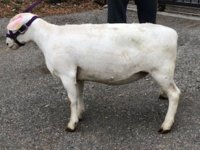
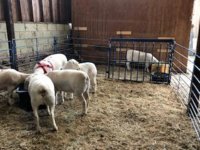 The final picture is of the ewes and ram in the barn relaxing. The ewe at the end of the barn is the one that won't be bred to Axtell but will go to one of the other rams. She is the half sister to Axtell and the second ewe pictured above. Ewes 1 and 3 have the same sire - an S Bar T ram. The 4th ewe is taller, lovely, and is out of similar bloodlines to my original ewes. The pictures are not that good since they had spent 48 hours in the trailer and 14 hours on the road. They were happy to be out of the trailer but nervous at being separated for the few minutes it took to walk them into the barn.
The final picture is of the ewes and ram in the barn relaxing. The ewe at the end of the barn is the one that won't be bred to Axtell but will go to one of the other rams. She is the half sister to Axtell and the second ewe pictured above. Ewes 1 and 3 have the same sire - an S Bar T ram. The 4th ewe is taller, lovely, and is out of similar bloodlines to my original ewes. The pictures are not that good since they had spent 48 hours in the trailer and 14 hours on the road. They were happy to be out of the trailer but nervous at being separated for the few minutes it took to walk them into the barn. 
